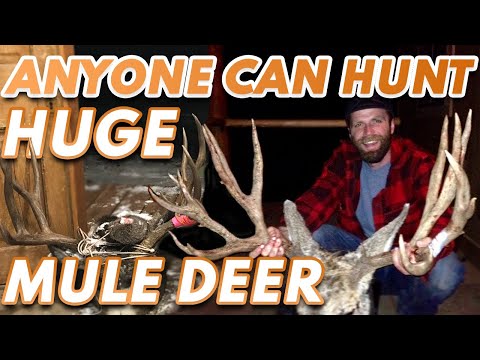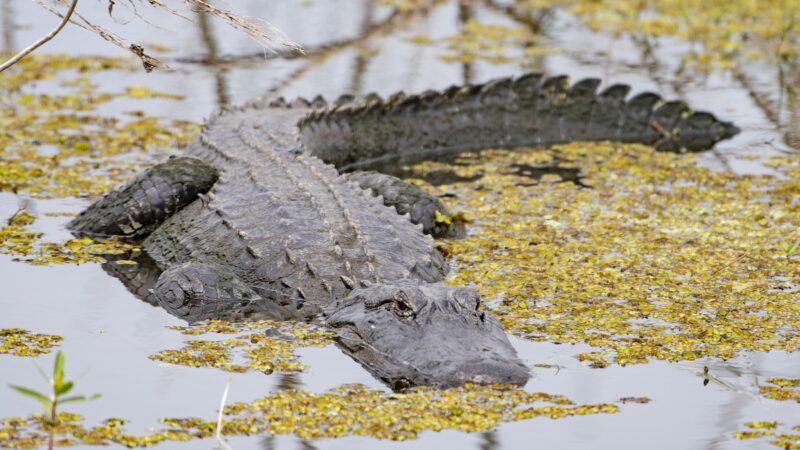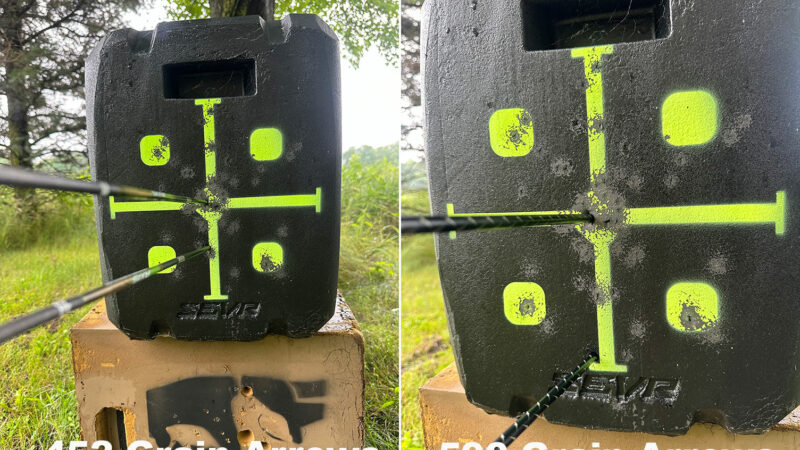Are You Stoked for Your DIY Western Big Game Hunt? Here’s What the Hunting Podcasts and Influencers Don’t Tell You
We were not 300 yards from camp when my buddy Brad froze in his tracks.
“There’s a buck right there,” he whispered as he grabbed for his binos and aimed them uphill. “It’s just a giant 2-point.”
But over Brad’s shoulder, less than 70 yards away, I could see another deer with its head down feeding.
As I nocked an arrow I replied, “What about that other buck?”
At that moment the 2-point trotted downhill, joined the second buck, and both slipped into the timber below us. So we cautiously stalked toward where we expected the deer to go and within minutes relocated them. This time they were only about 40 yards away, but the bucks had spotted us, too. Their ears and eyes were trained on us, front legs locked straight. We could see now that the “other buck” was a nice 4-point—probably a 150-class deer still in velvet. When the 2-point bounded back a few yards I went to full draw, hoping the commotion would distract from my movement.
We had been hunting for all of 15 minutes on the first day of the Utah general archery mule deer season, in an easy-to-draw unit, and in a popular national forest not far from Salt Lake City. Now all I needed was a window through the pines for which to thread my arrow through, and my mule deer hunting dreams would become reality.
If you’re an Eastern whitetail hunter like me, it’s easy to form a grandiose idea of Western hunting. After all, there’s a propensity for Americans to fantasize about high adventure in the West. When those fantasies are paired with endless podcast episodes and social media posts all about how great it is to hunt elk, antelope, and mule deer, well, it makes for a powerful cocktail.
But a more sober look at DIY Western hunting reveals that it’s not always as fun and definitely never as easy as it’s made to seem. Here’s why.
Listen Next: Podcast: The Biggest Myths in Mountain Hunting
In Many Units, Success Rates Are Painfully Low
That 4-point buck never did step into the open, and eventually both deer bounded off into the timber. Later that afternoon while trying to sneak into an ambush spot, I bumped a different buck — an even bigger one — from his bed. Both blown opportunities hurt badly, because I knew they were likely the only real chances I’d get, at least from a statistical standpoint.
The success rate for archery hunters in that unit was 4.2 percent last season. If you’re hunting public ground during a general season in the West, the odds will likely be stacked against you, too. In Colorado (the state with the largest elk herd), for example, the average success rate over all units and all methods of take was 16 percent in 2023.
This is not to say that out-of-staters can’t have consistent success while hunting public land in the West — just that the majority of us will end up eating our expensive non-resident tags.
And remember that game density varies greatly from region to region. Much of the West suffered a brutal winter in 2022, which wreaked havoc on mule deer, elk, and antelope numbers. Many units even closed hunting opportunities in 2023. It will take years for game numbers in those areas to recover. In the unit I was hunting, the mule deer population objective was 25,000 deer. The current population estimate is only half of that.
You’re Going to Be Dealing with Hunting (and Partying) Pressure
When we pulled into our national forest campsite the afternoon before the opener, I was a little surprised to see a fleet of RVs and campers spread around the area. It was opener eve, I know, but this place had the vibe of a popular campground on Fourth of July weekend. There were kids ripping around on four-wheelers and bros unloading their dirt bikes. There was also a platoon of hunters scattered about who were prepping their gear and slinging arrows at targets (the sound of errant arrows smashing into rocks added to the ambiance).
Brad could tell that I was skeptical about the situation.
“It’s like this every weekend,” he reassured me. “The deer are used to it. Some guys who hunt this unit let their hunting clothes sit in smoke, since the deer are so used to smelling campfires.”
And Brad was right. That first night of scouting we saw a few deer, including a shooter buck, not far from camp. Some guy drove by us on a fourwheeler, saw our optics and shouted over the rumble of his engine: “I just saw two big bucks run across the road up that way, I nearly ran into ‘em!”
Public land in the West gets used, especially early during the hunting season when the weather is still fair. Expect to see hikers, trail riders, campers, and other hunters wherever you go. But don’t get discouraged when you bump into these folks. Part of the challenge is figuring out how to hunt around them. The animals have figured out how to live around them.
One evening I had been especially cautious while sneaking into what I hoped to be a bucks bedding area. Just as the sun began to set behind the mountain and things started to feel right, I heard a dude scream “Whoo-hoo!!!” from across the creek bottom. When he screamed again I guessed that he was about 600 yards away on a dirt bike trail. For good measure he hollered two more times before moving on to crush beer cans with his forehead or whatever else folks like that do for entertainment.
“It’s like this every weekend,” I reminded myself as I waited silently through prime time. But no buck appeared, so I hiked back to camp in the dark.
Simply Hiking Farther Might Not Help
If you’re reading this thinking, Bro, you’ve got to keep hammering and just get in there deeper, then I would contend that it’s nice you’ve been listening to hunting podcasts. But it’s more complex than that.
It’s true that in some cases simply hiking deeper into the wilderness can help whittle down hunting pressure. But these days, with the benefit of onX, everyone can locate and access the same backcountry meadows, saddles, and springs that you can. When it comes to digital scouting, there are no more secrets.
Many of the locals who have hunted those wilderness areas for decades have horses and are willing to ride them into places that will make your flatlander legs quiver. Plus, the younger generation of serious homegrown Western hunters seems more than happy to walk through the valley of the shadow of death if it means they might find a big mule deer buck on the other side. Many of these young guns have structured their entire lives so that they have the best opportunities to hunt mature bucks and bulls on the same ground that you plan to hunt.
So don’t expect to find some untouched honey hole just because it’s far from the trailhead. No matter how far you plan to hike in, focus your strategy on hunting around other hunters, not getting away from pressure completely — that likely won’t happen.
The Hunters Who Have Consistent Success Put a Lot of Time into It
The key to DIY Western hunting success isn’t much fun to post about on social media: It takes years of earned knowledge that only comes through diligent scouting and hard hunting in the same unit, season after season.
Cliff Gray, a former outfitter and current hunting YouTuber drops some great points on this subject in the video below. Don’t let the video title fool you: What Gray is really talking about here is sustained hard hunting over the course of several seasons in order to find success.

Even the influencers who do post honestly about DIY Western hunts often get a good amount of help from locals and buddies with extensive knowledge of the area, or they’ve put a ton of time into the area themselves. No one should fault them for that, but it’s important to know that you can’t expect to drop into some general unit once and have an incredible hunt. It can even be tough hunting in limited entry units. For long-term success, it’s usually better to choose a unit that you can draw every year (or every few years) so that you can learn it over time. If you choose wisely and hunt hard, you’ll start killing bucks or bulls in due time.
My buddy Brad is employing this strategy himself. After giving up on his previous deer unit due to hunting pressure, he opted for a unit and a tag program that allows him to kill two bucks over the course of three years. This first year of hunting was essentially an early investment to gain knowledge for those future seasons. Nonresident hunters should develop the same sort of multi-year plan for hunting the West.
But … You Could Still Get Lucky
And yet, hope springs eternal in the heart of the Eastern deer hunter. So long as you have a tag and the time to hunt, there is a chance (albeit a small one) that you could shoot a slammer bull or buck on public ground, on your own.
I witnessed this first-hand several years ago during a DIY muzzleloader elk hunt in Colorado. One of my cousin’s friends was more or less tagging along on our hunt and ended up killing a 300-plus-inch bull in a popular unit that was easy to draw at the time. The local taxidermist said it was about as big of a bull as he’d seen come out of that public area in several years. The kid did it purely on his own, with incredible luck and a decent shot.
This could be your fate, too. But even if it’s not, you can still have a good time hunting those big Western landscapes so long as you have the right expectations going in.
The post Are You Stoked for Your DIY Western Big Game Hunt? Here’s What the Hunting Podcasts and Influencers Don’t Tell You appeared first on Outdoor Life.
Source: https://www.outdoorlife.com/hunting/hunting-west-diy-reality/




